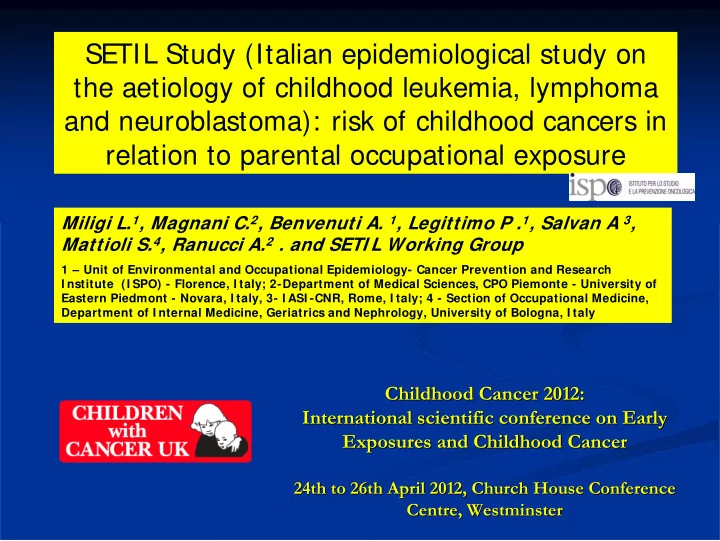

SETIL Study (Italian epidemiological study on the aetiology of childhood leukemia, lymphoma and neuroblastoma): risk of childhood cancers in relation to parental occupational exposure Miligi L. 1 , Magnani C. 2 , Benvenuti A. 1 , Legittimo P . 1 , Salvan A 3 , Mattioli S. 4 , Ranucci A. 2 . and SETI L Working Group 1 – Unit of Environmental and Occupational Epidemiology- Cancer Prevention and Research I nstitute (I SPO) - Florence, I taly; 2-Department of Medical Sciences, CPO Piemonte - University of Eastern Piedmont - Novara, I taly, 3- I ASI -CNR, Rome, I taly; 4 - Section of Occupational Medicine, Department of I nternal Medicine, Geriatrics and Nephrology, University of Bologna, I taly Childhood Cancer 2012: Childhood Cancer 2012: International scientific scientific conference on Early Early International conference on Exposures and Childhood Childhood Cancer Exposures and Cancer 24th to to 26th April April 2012, Church House Conference Conference 24th 26th 2012, Church House Centre, Westminster Centre , Westminster
Methods Cases: : children aged 0 to 10 years, resident in the 14 participating Cases regions and diagnosed in the period 1998-2001 with acute leukemia, non Hodgkin Lymphoma (NHL) or neuroblastoma . Controls : (2:1) were chosen at random using the national health service rolls, two controls were matched to each leukemia case on month of birth, sex and province of residence. Data Collection: Study subjects’ parents were interviewed by trained interviewers using a structured questionnaire. In the case of occupational history, detailed information was collected on all jobs held by parents using also “job specific questionnaires” Exposure Assessment: The collected data were reviewed by expert industrial hygienists to estimate the exposure to a list of agents : a general category “solvents” including all substances used as solvent, specific categories of chemical classes and individual chemicals Exposures were rated on two scales: “probability” and “intensity”, Parental occupational exposures were assessed considering 3 time windows: 1 year before conception, during pregnancy , after birth of child until diagnosis
Statistical analyses Statistical analyses Point estimates of odds ratios Point estimates of odds ratios (ORs ORs) and the corresponding confidence intervals (95% ) and the corresponding confidence intervals (95% ( CI) were calculated. All the analyses were performed CI) were calculated. All the analyses were performed using multiple logistic regression models, taking into using multiple logistic regression models, taking into account relevant potential confounders (sex, age, area). account relevant potential confounders (sex, age, area). Separate analyses were conducted for maternal and Separate analyses were conducted for maternal and paternal exposures. Analyses were performed for each paternal exposures. Analyses were performed for each agent with medium or high assigned probability of agent with medium or high assigned probability of exposure for all levels of intensity and for different exposure for all levels of intensity and for different Parents who never used any of the time windows. Parents who never used any of the time windows. listed chemicals were used as the referent population listed chemicals were used as the referent population A total of 685 leukemias leukemias, 98 NHL, 155 , 98 NHL, 155 . A total of 685 Results. Results neuroblastomas and 1,047 controls were interviewed neuroblastomas and 1,047 controls were interviewed Results for leukemia were reported for selected exposure (chemical classes al classes Results for leukemia were reported for selected exposure (chemic or individual substances) when there were at least five exposed cases. cases. or individual substances) when there were at least five exposed
Number of cases and controls, ORs* , 95% confidence intervals (95% CI ) for leukemia 5% CI ) for leukemia Number of cases and controls, ORs* , 95% confidence intervals (9 by parental exposure to chemical classes (* Adjusted by gender, age, and area) all by parental exposure to chemical classes (* Adjusted by gender, age, and area) all intensity levels and probability of exposure > low intensity levels and probability of exposure > low Chemical Father Mother classes Exp. Exp. OR CI 95% Exp. Exp. OR CI 95% cases Controls cases controls Chemicals MOTHER MOTHER Solvents 132 189 1.1 0.9-1.4 58 80 1.1 0.8-1.6 Exp. Exp. OR CI 95% Exp. Exp. OR CI 95% cases Controls cases Controls Aromatic 6 3 3.1 0.8-12.4 Benzene 74 98 1.2 0.9-1.6 21 18 1.8 1.0-3.4 hydrocarbons 14 12 1.8 0.8-4.0 Toluene Chlorinated 40 61 1.0 0.7-1.5 24 33 1.1 0.7-1.9 13 10 2.0 0.9-4.7 Xylene hydrocarbons Aliphatic h. 42 69 0.9 0.6-1.4 20 13 2.4 1.2-4.9 Oxygenated 55 75 1.2 0.8-1.7 34 45 1.2 0.7-1.9 organic compounds Mineral oils 97 109 1.4 1.1-1.9 10 17 0.9 0.4-2.0 Diesel exhaust 134 154 18 20 1.4 0.7-2.6 1.4 1.1-1.8 fumes Lead 49 47 1.7 1.1-1.5 6 9 1.0 0.4-2.8
Figure – Aromatic Hydrocarbons - Parental exposure ORs, 95%CI for leukemia by time windows 10 9 8 7 6 5 4 3,8 3 2,2 2 1,6 1,2 1,2 1,1 1 0 Preconception During pregnancy After birth Preconception During pregnancy After birth Mather Father
Final remarks Final remarks We found increased risk of selected childhood cancers associated with parental exposures to some chemical classes of solvents, particularly maternal exposure to aromatic and aliphatic hydrocarbons. I ncreased ORs were also observed for paternal exposure to diesel exhaust fumes and mineral oils exposure. Analyses by time windows shown increased risks for Analyses by time windows shown increased risks for mother’ ’s exposures particularly in the preconception s exposures particularly in the preconception mother period. period. Our results suggest that some parental occupational exposures may be a risk factor for the development of selected types of childhood cancer
Recommend
More recommend